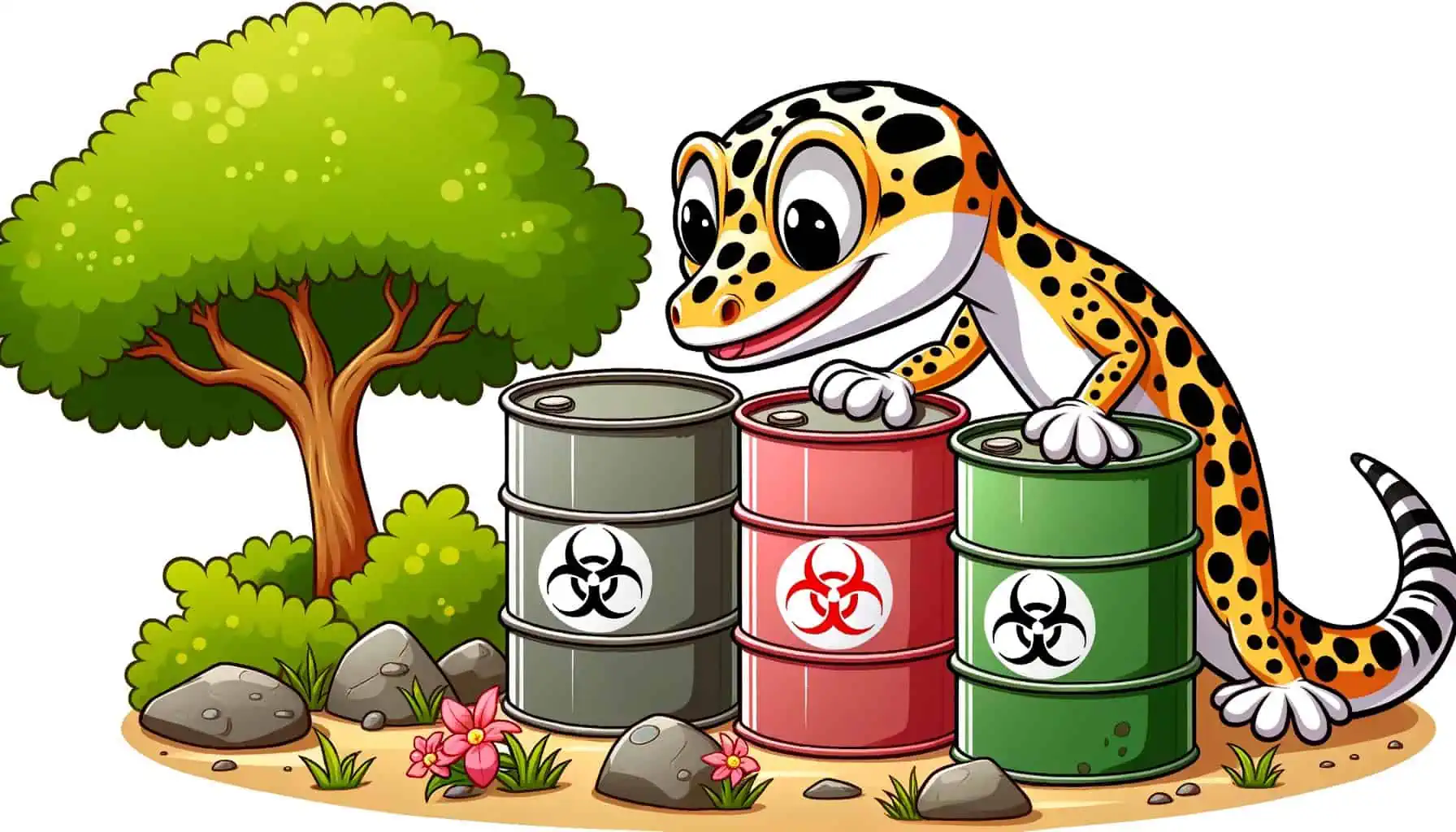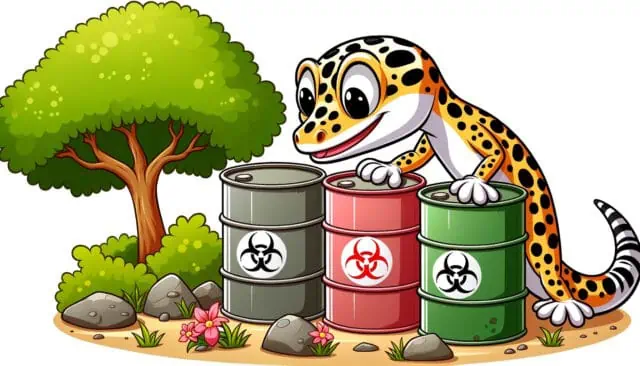Leopard geckos are exposed to a variety of toxins in their environment. Understanding what is toxic to these reptiles is crucial for their health and well-being. Common household items, outdoor substances, and even certain pet care products can pose a threat to them. Ensuring their safety means being aware of these dangers and taking preventive measures.
Household Toxins: Common items like bleach and Lysol, as well as certain plants, are toxic to leopard geckos. Keep these items away from their enclosures.
Outdoor Dangers: Chemicals used outdoors, such as pesticides, herbicides, and swimming pool treatments, can be hazardous. Be cautious if your gecko spends time outside or if you introduce outdoor elements into their habitat.
Food and Supplements: Human foods and beverages can be harmful to leopard geckos. Calcium supplements are essential, but if using a UVB source, opt for calcium without Vitamin D3 to maintain a proper calcium and phosphorus balance.
What is Toxic to Leopard Geckos?
Leopard geckos are popular reptiles kept as pets. Their hardy nature and docile temperament make them a favorite among reptile enthusiasts. However, like all animals, they have specific needs and vulnerabilities. There are numerous household toxins that can pose a significant threat to their health.
Household toxins harmful to leopard geckos include cleaning products, certain plants, some human foods, and many others. Exposure to these toxins can lead to various health issues ranging from mild irritation to severe health complications or even death. Common symptoms of toxin exposure in leopard geckos include lethargy, loss of appetite, skin irritation, and abnormal behavior. It’s crucial for leopard gecko owners to be aware of these toxins and keep them away from their pet’s environment.
One might wonder, why are leopard geckos so vulnerable to these household toxins? The answer lies in their physiology and natural behaviors. These cold-blooded reptiles have permeable skin, which means they can easily absorb substances from their environment. Additionally, in their natural habitat, they are instinctively curious and tend to lick or taste objects to explore their surroundings. This behavior makes them more prone to ingesting or coming into contact with harmful substances in a household setting.
Household Toxins
Many common items found in our homes can be potentially harmful to leopard geckos. While these products are safe for humans, they might not be for our reptilian friends.
Cleaning Products
Cleaning products like bleach, Lysol, Pine-Sol, and Spic-n-Span are essentials in many households for maintaining cleanliness. However, they pose significant hazards to leopard geckos. These products often contain toxic ingredients, such as phenols, which can be deadly to geckos if ingested.
Given the curious nature of leopard geckos, it’s not uncommon for them to come into contact with residues of these cleaning agents, especially if their enclosures are cleaned without thorough rinsing.
For those seeking safer alternatives, chlorhexidine is a reliable option. This antiseptic is less toxic and can be used to clean leopard gecko enclosures. Nonetheless, always consulting a veterinarian for product recommendations and cleaning guidelines is a wise decision.
Insecticides
Insecticides are commonly used in households to combat pests. However, they present clear dangers to leopard geckos.
These chemicals are designed to kill, and their toxic nature doesn’t discriminate between pests and pets. When used around geckos, there’s a risk of them inhaling the chemicals or coming into direct contact with treated surfaces.
Moreover, it’s crucial to ensure that insecticides don’t contaminate the gecko food. Ingesting food tainted with these chemicals can lead to serious health complications or even fatality.
For those looking for safer ways to manage pests, there are natural methods available. Diatomaceous earth, a type of soft sedimentary rock that crumbles into a fine white powder, can be sprinkled in areas where pests are prevalent. It acts as a natural insect killer without posing harm to geckos.
Another option is using hedge-apples, which are known to repel insects. Placing them in strategic locations can deter pests from invading gecko spaces.
Air Fresheners and Candles
Many households use air fresheners and candles to create a pleasant ambiance or mask unwanted odors. However, what might seem refreshing to us can be hazardous to leopard geckos. Products like aerosol sprays, plug-in fresheners, scented candles, and even some essential oil diffusers can be toxic to these reptiles.
The chemicals and fragrances in these products can cause respiratory irritation in leopard geckos. Their respiratory systems are sensitive, and exposure to strong scents or chemicals can lead to difficulty in breathing or other respiratory issues.
Additionally, if a gecko comes into direct contact with liquid air fresheners or ingests any particles from these products, it can lead to further complications due to their toxic nature.
Plants and Flowers
While plants and flowers can enhance the aesthetics of a home, not all are safe for leopard geckos. Some toxic plants and harmful flowers can adversely affect their health if ingested or even just by contact. It’s vital for gecko owners to know which plants pose a threat and which are safe to keep around.
Common plants and flowers that are toxic to leopard geckos include Poinsettia, Azalea, Oleander, and certain types of Ivy. These should be avoided in and around their enclosures, as ingestion or skin contact can lead to health issues ranging from skin irritations to digestive problems.
For those wanting to add some greenery to their gecko’s habitat, there are safe alternatives. Spider plants, Boston ferns, and succulents like Haworthia and Aloe are safe for leopard geckos. These plants not only pose no threat but can also enhance the enclosure’s environment. However, always ensure that any plant introduced is free of pesticides or other chemicals.
Human Foods and Beverages
Many of the foods and beverages consumed by humans are not suitable for leopard geckos. While these items may be nutritious for us, they can be toxic to these reptiles. It’s essential to understand the potential dangers to ensure the safety and well-being of our gecko companions.
Common human foods that can be toxic to leopard geckos include chocolate, caffeine, alcoholic beverages, dairy products, and any foods high in sugar or salt. These items can disrupt their digestive system, cause metabolic imbalances, or even lead to poisoning.
The reason to avoid giving these foods and beverages to leopard geckos is simple: their digestive systems are different from ours. What’s harmless or even beneficial for humans might be harmful or fatal to them.
Medications and Cosmetics
Household medications and cosmetics are a common presence in our homes, but they can pose significant risks to leopard geckos. These products, designed for human use, contain ingredients that might be toxic or harmful to reptiles. Even small amounts can lead to health complications, making it imperative to store them safely away from gecko habitats.
Certain over-the-counter medications, like triple antibiotic ointments, can be particularly harmful if ingested by leopard geckos. While these ointments might be beneficial for humans, they can become toxic to geckos over time if ingested or if they come into contact with their skin.
The same goes for many cosmetics, which often contain chemicals and fragrances not suitable for these reptiles.
Examples of common medications and cosmetics to avoid include pain relievers like ibuprofen or acetaminophen, creams with added fragrances, and certain lotions or moisturizers. Unless a product is specifically recommended by a veterinarian, it’s best to keep it away from leopard geckos.
Outdoor Toxins
While indoor environments have their share of potential hazards for leopard geckos, the outdoors introduces a whole new set of risks. From garden chemicals to predatory animals, the outdoor world can be a treacherous place for these delicate reptiles.
Pesticides and Herbicides
Pesticides and herbicides are substances commonly used in gardens and lawns to combat pests and unwanted plants. While they serve a purpose in maintaining outdoor spaces, they can be extremely toxic to leopard geckos. These chemicals are designed to kill or repel, and their harmful nature can affect more than just their intended targets.
Using pesticides and herbicides near gecko enclosures can expose these reptiles to these dangerous chemicals. Residue from sprays can easily find its way into enclosures, especially if they are placed outdoors or near open windows. Such exposure can lead to health complications ranging from skin irritations to respiratory issues.
Common pesticides like permethrin, malathion, and carbaryl, as well as herbicides like glyphosate, are particularly toxic to leopard geckos. It’s essential to avoid using these and similar toxic substances near gecko enclosures to ensure their safety.
Carnivorous Animals/Insects
While leopard geckos are predators themselves, feeding on various insects, they can also fall prey to larger carnivorous animals and insects. The outdoor environment is home to various creatures that can pose a threat to these small reptiles, either by directly preying on them or through toxic interactions.
For instance, certain spiders, such as the brown recluse or black widow, carry venom that can be harmful to leopard geckos if bitten. Similarly, larger predators like birds of prey, raccoons, or even domesticated cats and dogs might see a leopard gecko as potential prey.
The potential risks these animals and insects pose are significant. From physical harm, like bites or scratches, to the stress of a predatory encounter, these interactions can jeopardize the well-being of geckos. It’s crucial for owners to be aware of these dangers, especially if their gecko spends any time outdoors or if they bring outdoor elements, like plants, into their gecko’s living space. Taking precautions, such as secure enclosures and regular environment checks, can help minimize these risks.
Swimming Pool Chemicals
Swimming pool chemicals are essential for maintaining clean and safe pool water for human use. However, these chemicals can be highly toxic to leopard geckos. The substances used to treat pool water, such as chlorine, bromine, and algaecides, ensure that pools remain free from harmful microorganisms. But for leopard geckos, even minor exposure can lead to serious health issues.
These chemicals can cause skin irritations, respiratory problems, and other adverse reactions in geckos. Ingesting water treated with these chemicals or coming into direct contact with them can lead to harmful effects that can jeopardize their health.
For leopard gecko safety, it’s crucial to take several precautions.
Firstly, never allow a leopard gecko to come into contact with pool water or any area where pool chemicals are stored or used. If a gecko’s enclosure is situated near a pool area, ensure that it’s adequately sealed to prevent any chemical fumes from entering.
Regularly check and clean the gecko’s living space to ensure no accidental exposure. If a gecko is suspected of coming into contact with these chemicals, it’s essential to consult a veterinarian immediately.






